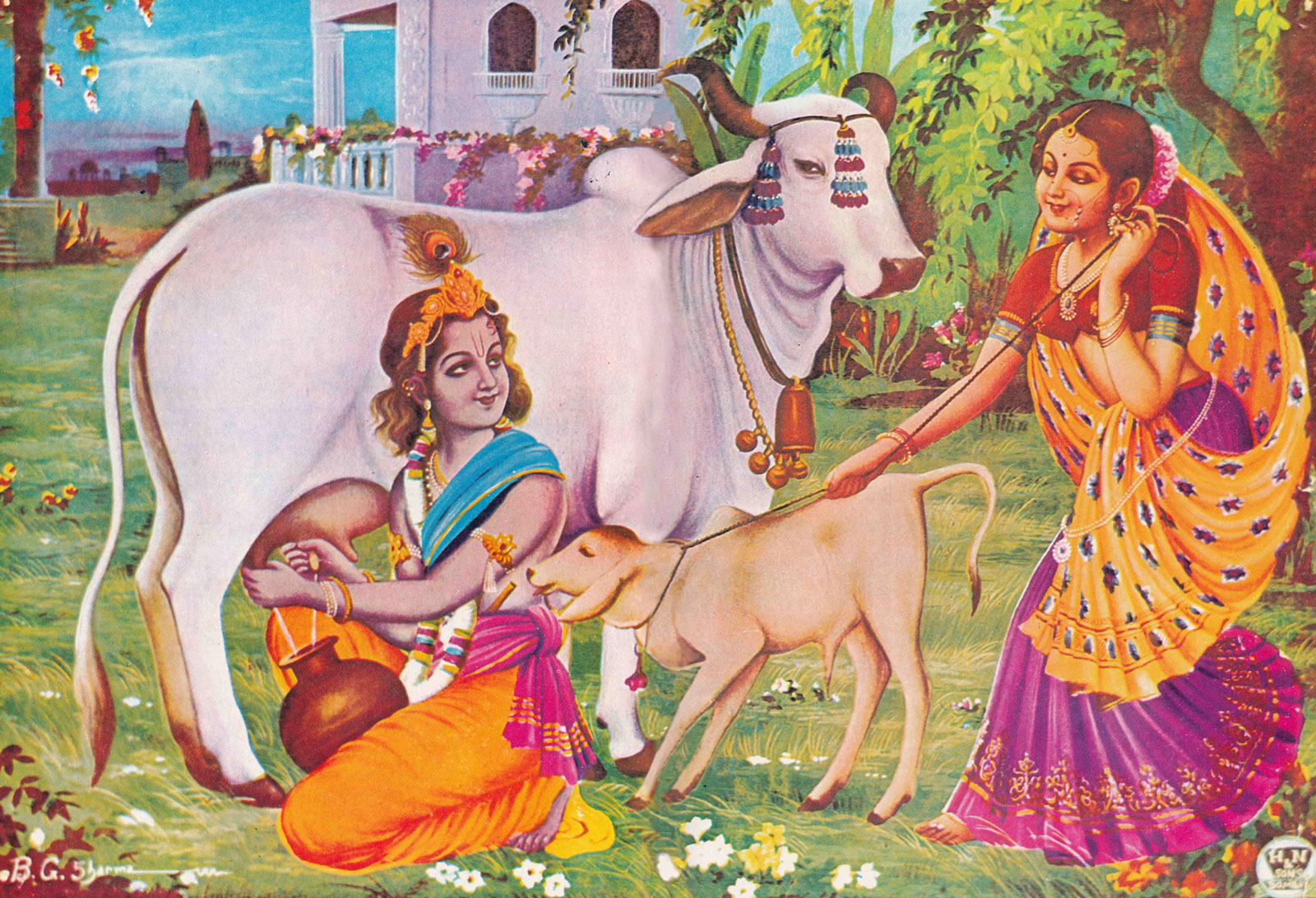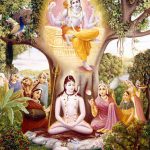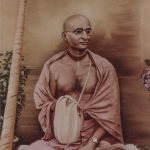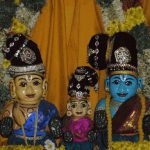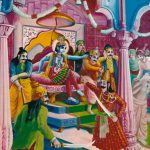by Swami B.V. Tripurari
Q. Why is Vrindavana considered a holy place?
A. A place becomes pious because the Lord’s devotees are present there. If the Lord’s devotees are present, chanting his name, then the Lord is present there as well. This is what makes a place holy, a tirtha for crossing over material existence to the other side. What was Vidura told? He wanted to go traveling on pilgrimage to the holy places, tirtha-yatra. But Maharaja Yudhisthira told him, “What is the use of that? Verily, persons like yourself are places of pilgrimage because you carry the Lord in your heart wherever you go.’” So saintly persons make a place holy, sacred and pious, because they make the Lord present there.
Q. So Vrindavana is a pious place?
A. Vrindavana is the supremely pious place and wherever Krishna walks in the forests everything becomes even more pious. We pilgrims go throughout Vrindavan, worshipping the dust, putting it on our head at all the places. But in some places we find the footprint of Krishna and this makes it even more pious, more auspicious. At the Radha-Damodara temple we can have the darsana of the footprint of Krishna in the stone from Govardhana. There are places out in the Vraja also where we can find the footprints of Krishna melted into the stone, and these places have become ever more pious by his footprint. And never any shoes there—only barefoot. Krishna goes cowherding barefoot.
We cannot enter Krishna lila with our shoes on—shoes by which we are tracking so much dirt and dust from our material sojourn. They must be left aside. “No shoes,” this is the idea. Barefoot means walking without any anxiety.
Mother Yasoda, of course, is in a little anxiety about Krishna walking barefoot. But Krishna replies, “You don’t have to worry. Vrindavana is such a nice place. There are beautiful deer dusting the trails, making them soft and sandy-like beaches. The cows walk ahead and break the ground and soften it for me to walk upon. And the trees bend down and sweep the trails making everything very soft.” In Vrindavana the whole environment rises up to serve Krishna in every way. Mother Yasoda is concerned about his tender feet and the young gopis are also concerned. But Krishna assures them there is no cause for concern. Still they remained concerned. The nature of Vrindavana-dhama, the abode of the Lord, is such that it facilitates the service of Krishna in every way.
Q. But for us in the material world we are not so inclined to serve Krishna?
A. In the material world we are struggling against nature to serve Krishna. It seems as if we are moving against the current. But when we fully absorb ourselves in Krishna consciousness we find that nature comes to serve and facilitate us. Srila Sridhara Maharaja used to say in his own poetic language, “the environment is friendly.” But we see the environment as unfriendly. We think we are friendly but the environment is not cooperating with us. But the vision of the great souls, the maha-bhagavatas, is just the opposite. The kanistha-adhikari thinks, “I am doing such nice service but other people are not cooperating. I could serve very nicely if other people would just stop getting in my way.” They think, “Oh, I am a devotee. Everyone else, to one extent or another, is opposed to my devotion.” And the uttama-adhikari thinks just the opposite. He sees everyone as a devotee. He thinks everything, even inanimate things, are offering better service to Krishna than himself, “It is only I who am not a servant of Krishna.”
We have to think about the things that we are doing in devotional service. We must move from kanistha-adhikari to uttama-adhikari by this kind of discrimination which is characteristic of the madhyama-adhikari—thinking about things with introspection. I may not think like an uttama-adhikari, but I should know theoretically how they think. So far as it is understandable, as it is described in the Bhagavatam, I should try to comprehend this vision. The gopis are offering respect to the trees, to the deer, to the earth itself. What is in their heart?
As the Bhagavatam says,”atmavan manyate jagat“. What is in our heart, we project that, seeing it in others. So the gopi‘s prema, their love of Krishna, is so great that they see everyone and everything as loving Krishna better than themselves. So we should try to cultivate this kind of thinking in a general way, like a madhyama-adhikari, with discrimination, thoughtfulness, and introspection in our devotional culture. The life of the sadhaka is not mechanical. It is a very thoughtful life. Does scripture tell us not to use our mental and rational capacity?
We want to awaken our sva-dharma. Now we have dharma according to karma, a particular psycho-physiological makeup. But we have another nature that we are to awaken, “paro dharma.” This is Srimad Bhagavatam‘s message, this is Krishna dharma, “ahuituki apratihata yayatma suprasidati,” that by which the supreme Self is fully satisfied and accordingly, by which we will be fully satisfied. That is service to Krishna, it is causeless, it is not a product of the world of cause and effect. It is beyond karma. It is causeless, it is beginningless and it is without end. And its nature is such that those who are possessed of it will not end or stop at anything to satisfy Krishna. The whole of the Vraja is moving like that. They will let nothing get in their way to satisfy Krishna. This is Krishna dharma, paro dharma, prema dharma.
Q. How do we understand Vrindavana, Vraja?
A. Vraja is different things to different people. But for the devotees it is the very love of Krishna itself taking practical shape, manifesting. We can draw from it symbolically in so many ways. But not in such a way that the lila disappears and becomes only a symbol for something else. Vraja is the be all and end all. It is known by very few people. Very, very rarely achieved. But “golokera prema dhana, hari nama sankirtana.” Mahaprabhu is making it so widely available. So if we want to go there, we have to be a little thoughtful about what that place is. And we should read Srimad Bhagavatam like this. If you want to do smarana, start in this way. This is practical. Not that you sit down and imitate great devotees and go to hell. Study Srimad Bhagavatam: “What is Krishna-lila? What is Brahma-vimohan lila? What is this Dhenukasura lila?”
Dhenukasura lila—here we are studying the first verse, Krishna enters into pauganda lila, he becomes initiated as a cowherder, bare-footed he goes into the forest “sakhibi-saman” he is not alone, he goes with all of his friends. Mother Yasoda says, “Rama, you stand in the front, and Subal by your very nature you’d better stand behind, and Sridama on one side, another on the other side. Protect him on all sides.” So he is going sakhibi-saman, with his friends and cows, bare-footed, making the already supremely pious Vrindavana that much more pious wherever he walks.
And we shall walk with him, through the forest. In this Dhenukasura lila, so many nice things are found, so many treasures, so many jewels. Krishna’s friends are mentioned: Subal, Stoka-Krsna, Sridama, their names are given in this chapter. Baladeva’s lila, his relationship as guru of Krishna, also comes out. Krishna glorifies the forest of Vrindavana, he glorifies Baladeva. Balarama lays down, Krishna massages his feet. Baladeva has this kind of relationship with Krishna as his guru, as servant, and also as friend—threefold.
As this lila progresses in the Bhagavatam the whole of the pauganda lila is given in an aphoristic style, like a sutra. After killing Dhenukasura, Krishna is returning from the forest and Radhika and the other gopis are greeting him as he returns. Glancing at him and he glancing at them in this purva-raga, where the beginning of love is kindling. Then he moves into the kaliya-damana lila and gives a glimpse of rasa-lila to all the gopis, dancing on the heads of Kaliya, offering a sneak preview so to speak, “I am a good dancer—just see!”
Q. Is this lila-smaranam?
A. We should do kirtana, then nama-smaranam—our japa, then study the lila of Krishna. This is a kind of smaranam. We want to study Bhagavatam, the Tenth Canto like this, in good company and catch the spirit of it. And we will be captivated by it. There is nothing more powerful to captivate the mind than this. We should know when Krishna did this, when Krishna did that. We call ourselves devotees of Krishna but we don’t know any of these things, we have no interest. So rather than trying to jump ahead, do this.
Study Srimad Bhagavatam, the Tenth Canto especially, under good guidance, then gradually the lila will awaken in your heart. In all the details that are not overtly here, they will come out. Not only details that are found by other acaryas but you will find your own details. You will write your own page in the book of Krishna lila and your name will be signed at the bottom, like Gopa Kumar. He became Sarupa and was placed into the cowherd community by Krishna himself as he entered Goloka. He became a friend of Krishna by Radharani’s krpa, who came to him as his gurudeva. So let us not go on with our spiritual life in any mechanical or artificial way—but in a real way.


